» posted on Monday, November 5th, 2012 by Linda Lou Burton
Simplicity in Symbolism
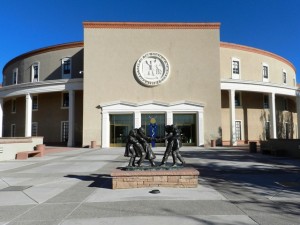 Linda Burton posting from Santa Fe, New Mexico – Clean modern lines reflecting ancient traditions – how do you combine that into a stunning and meaningful setting appropriate for the business of the state? New Mexico is one of the newer states (47th in 1912) and now has one of the newer capitol buildings (dedicated 1966). It also has the oldest – the Palace of Governors (1609) still stands on the north side of the Plaza, as the state museum. In between, New Mexico had an elaborate Victorian capitol (1886) which citizens called “audacious” and a traditional capitol with a silver dome (1900) which was often criticized as not being appropriate for the state; in 1950 the dome was removed. Building #4 seems to have done the trick for New Mexico; its New Mexico Territorial style – that unique combo of Greek Revival and Pueblo adobe – fits the ambiance, and the sensibilities, of the capital city. When viewed from above you can see that the unusual circular building resembles the Zia Sun Symbol, with four entrance wings protruding from the main center. That Zia symbol represents values important to the people of New Mexico.
Linda Burton posting from Santa Fe, New Mexico – Clean modern lines reflecting ancient traditions – how do you combine that into a stunning and meaningful setting appropriate for the business of the state? New Mexico is one of the newer states (47th in 1912) and now has one of the newer capitol buildings (dedicated 1966). It also has the oldest – the Palace of Governors (1609) still stands on the north side of the Plaza, as the state museum. In between, New Mexico had an elaborate Victorian capitol (1886) which citizens called “audacious” and a traditional capitol with a silver dome (1900) which was often criticized as not being appropriate for the state; in 1950 the dome was removed. Building #4 seems to have done the trick for New Mexico; its New Mexico Territorial style – that unique combo of Greek Revival and Pueblo adobe – fits the ambiance, and the sensibilities, of the capital city. When viewed from above you can see that the unusual circular building resembles the Zia Sun Symbol, with four entrance wings protruding from the main center. That Zia symbol represents values important to the people of New Mexico.
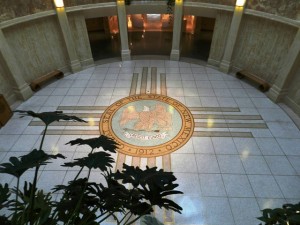 The Zia symbol is a circular sun with linear rays extending in four directions; it was inspired by a design found on an ancient water jar from Zia Pueblo. To the Zia people four is a significant number. There are four points on the compass (north, east, south, west), four seasons in the year (spring, summer, fall, winter), four times of day (sunrise, noon, evening, and night), and four divisions of life (childhood, youth, adulthood and old age). Everything is bound together in a circle without beginning and without end. The Zia believe too that in the Great Brotherhood of all things, people have four sacred obligations: they must develop a strong body, a clear mind, a pure spirit, and a devotion to the welfare of their people.
The Zia symbol is a circular sun with linear rays extending in four directions; it was inspired by a design found on an ancient water jar from Zia Pueblo. To the Zia people four is a significant number. There are four points on the compass (north, east, south, west), four seasons in the year (spring, summer, fall, winter), four times of day (sunrise, noon, evening, and night), and four divisions of life (childhood, youth, adulthood and old age). Everything is bound together in a circle without beginning and without end. The Zia believe too that in the Great Brotherhood of all things, people have four sacred obligations: they must develop a strong body, a clear mind, a pure spirit, and a devotion to the welfare of their people.
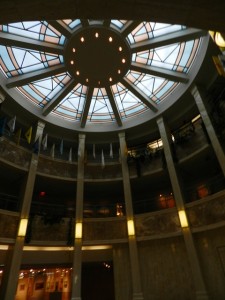 Stand on a balcony in the capitol rotunda and look down at a gleaming marble rendition of the Zia symbol, with the Great Seal of New Mexico inlaid in the center in turquoise and brass. The rotunda is 49 feet in diameter and 60 feet high; look upward to see a skylight resembling an Indian basket weave. Its blue and pale pink stained glass represent sky and earth. The colorful flags on the fourth floor balcony are on permanent display; they represent New Mexico’s 33 counties.
Stand on a balcony in the capitol rotunda and look down at a gleaming marble rendition of the Zia symbol, with the Great Seal of New Mexico inlaid in the center in turquoise and brass. The rotunda is 49 feet in diameter and 60 feet high; look upward to see a skylight resembling an Indian basket weave. Its blue and pale pink stained glass represent sky and earth. The colorful flags on the fourth floor balcony are on permanent display; they represent New Mexico’s 33 counties.
The rotunda is not the only place to see the Great Seal; a white plaster version hangs above each of the four outside doors; a gray metal version hangs in both Senate and House chambers. The seal has changed little since the Territorial seal of 1851. The American bald eagle shielding the smaller Mexican eagle within its wings symbolizes New Mexico’s change of sovereignty in 1846. The bald eagle, which represents bravery, skill and strength, clasps three arrows in its talons. The smaller Mexican brown harpy eagle grasps a snake in its beak 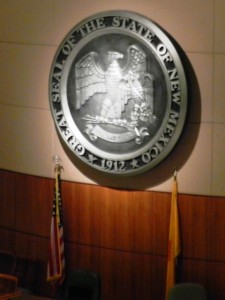 and cactus in its talons. This portion of the seal is still the official symbol of Mexico; it illustrates the ancient myth in which the gods ordered the Aztecs to settle where they saw an eagle perched on a cactus devouring a serpent. The scroll below the American and Mexican eagles contains the motto Crescit Eundo or, translated from Latin, It Grows as It Goes. The date 1912 was added to the seal when New Mexico was admitted as the 47th state. The word territory was replaced by state in that year.
and cactus in its talons. This portion of the seal is still the official symbol of Mexico; it illustrates the ancient myth in which the gods ordered the Aztecs to settle where they saw an eagle perched on a cactus devouring a serpent. The scroll below the American and Mexican eagles contains the motto Crescit Eundo or, translated from Latin, It Grows as It Goes. The date 1912 was added to the seal when New Mexico was admitted as the 47th state. The word territory was replaced by state in that year.
When you take the capitol tour, you can access the galleries overlooking the Senate and House chambers where New Mexico’s 42 senators and 70 representatives meet; the chambers are actually below ground and the galleries on the first floor. Inside the chambers simplicity is key; soft grays and blues complement wood paneling. The Legislature meets for  60 days in odd-numbered years and 30 days in even-numbered years; members are not paid for their legislative work but receive a daily living allowance when in session. The Governor and Lieutenant Governor have offices on the fourth floor; committee offices are on other upper floors.
60 days in odd-numbered years and 30 days in even-numbered years; members are not paid for their legislative work but receive a daily living allowance when in session. The Governor and Lieutenant Governor have offices on the fourth floor; committee offices are on other upper floors.
Next door to the main capitol is look-a-like Capitol North; it was dedicated in 2000 and houses legislative, executive, and judicial offices; an underground walkway connects the two buildings and is brimming with artwork, as is the main capitol, where every hallway is adorned, thanks to the Capitol Art Foundation. 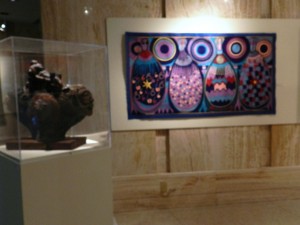 This nonprofit organization was established by the legislature in 1991 with the mission of collecting, preserving, exhibiting, interpreting, and promoting appreciation of works of art that reflect the rich and diverse history, cultures, and art forms of the people of New Mexico. The Governor’s Gallery, a separate entity, was founded in 1975 as a venue for presenting the arts to a broad public and also serves as an outreach facility of the Museum of Fine Arts.
This nonprofit organization was established by the legislature in 1991 with the mission of collecting, preserving, exhibiting, interpreting, and promoting appreciation of works of art that reflect the rich and diverse history, cultures, and art forms of the people of New Mexico. The Governor’s Gallery, a separate entity, was founded in 1975 as a venue for presenting the arts to a broad public and also serves as an outreach facility of the Museum of Fine Arts.
Simplicity in symbolism continues on the outside grounds; the 6.5-acre garden has more than 100 varieties of plants and a number of statues of native Pueblo peoples. The bright gold state flag furls out in the breeze above it all, a simple Zia symbol in red, representing the colors of old Spain.
New Mexico State Capitol http://www.nmlegis.gov/lcs/visitors.aspx
New Mexico Capitol Art Collection http://www.nmcapitolart.org/
